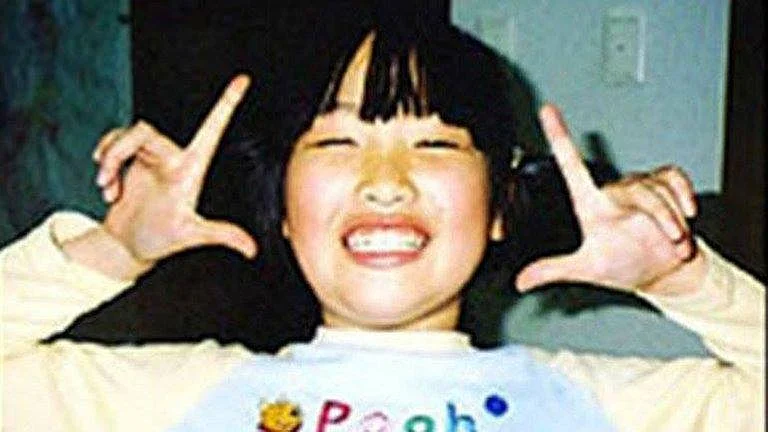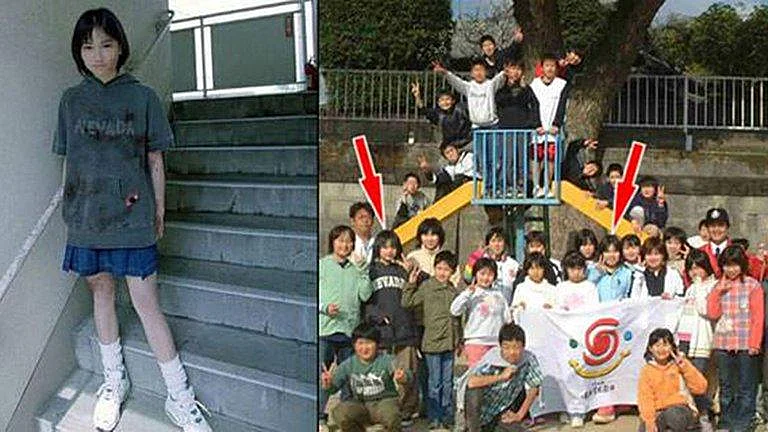With IQ of genius, Natsumi Tsuji (11) slit her classmate’s throat

At the age of 11, Natsumi Tsuji slit her classmate’s throat because she called her “fat”: the little murderess with the IQ of a genius.
The crime shocked Japan and the world. A girl with excellent grades and an IQ of 140 had murdered her friend at school. The press called her Nevada Tan, and investigators looked into what drove her to such horror. Her obsession with horror movies, the hoax she planned for the crime, and the gory photos went viral. Why she became a macabre teen icon?
That Tuesday, June 1, 2004, would be unlike any other Tuesday at Okubo Elementary School in Sasebo, Nagasaki, Japan. Natsumi Tsuji (11) invited her close friend Satomi Mitarai (12) into an empty classroom at lunchtime. She wanted to teach her a new, very entertaining game.
Natsumi would guide her. She sat Satomi on a chair, took off her glasses, and carefully placed them on a neighboring bench. She told her she was going to die. Despite that, Satomi didn’t run away. After all, it was just a game.
Natsumi explained that she should not look and asked if she would like a towel over her eyes. Satomi refused. Natsumi then covered her friend’s eyes with one of her hands and, with the other, pulled out a sharp box cutter and plunged it into the middle of her neck. With her throat slit open, Satomi had no voice to call for help and was unable to defend herself. Natsumi continued to unleash her rage and slashed both her wrists. Satomi lay on the floor of the empty classroom, agonizing in total silence.
Her assassin calmly left and walked to her classroom. On the way, she had to descend a staircase. Several students saw her descending the steps with blood on her clothes and her grey overalls. One of them took out his mobile phone and captured several images. One of these pictures or an imitation of her goes around the world.
Natsumi walked on impassively and entered her classroom. The surprise, upon seeing her bloodied, was widespread. The teacher, who had already noticed that the two little girls were missing, panicked. He rushed off to find Satomi. Natsumi followed behind him, crying and repeating, “I have done something wrong”.
By the time the ambulance arrived, Satomi’s heart had already stopped from massive blood loss. Everyone’s shock was palpable: the murderous hands were only 11 years old.
The dark side of normality
Japanese student Natsumi Tsuji was born on November 21, 1992. Her childhood was, on the surface, normal. The little girl showed enthusiasm for sports and played basketball for the school team. She had excellent grades and a very high IQ: she scored close to 140 points, a score that only 0.5 percent of the population has. She loved playing with cats and watching movies. She looked like a healthy, happy, growing child.
When sports began to take up too much of her time, her mother noticed a slight drop in her grades. She became concerned and asked her to stop basketball temporarily. Natsumi turned to the internet. She began to spend hours and hours locked in her room, watching horror movies.
She became a fan of anime and manga (animated, illustrated, or printed stories, which are artistic expressions originating in Japan). One day, when she saw the Japanese film Battle Royale, she was shocked: the film was about a futuristic society in which 42 students were sent to a desert island where they had to survive by killing each other. Natsumi Tsuji became obsessed with the world of gore, a term used to refer to a genre of film where films feature extreme explicit violence.
Around this time, she came up with the idea of creating her website with horror animations. It was an immediate success, and she began to make a name for herself in the gore genre.
One day, she had an argument with Satomi Mitarai, her classmate and best friend. Satomi told her that she was much more popular and then posted a message on Natsumi’s site calling her “fat” and “pretentious”. Natsumi was very angry and demanded an apology. Satomi paid no attention to her friend’s anger and unwittingly became the focus of her growing rage.

Natsumi, who had taken up basketball again, gave it up again. This time it was of her own free will. Her school grades again began to drop. In her diary, she wrote: “I don’t really like playing with my friends”. She became aggressive towards her classmates and her family. She kicked boys of her age and pushed them hard against walls.
While this was happening at school, at home, she continued with her blog dedicated to horror. She had established herself as an online reference. She was obsessed with the TV series Monday Mystery Theater, where many people were killed with box cutters or small knives.
During those weeks, she starred in a violent episode where she threatened a classmate with a box cutter. Less than a month after Satomi’s “fat” epithet, the real revenge would come. It would be in a classroom and without direct witnesses.
On June 1, 2004, Natsumi’s entire class gathered in the schoolyard for the typical annual school photo. In that photo, Natsumi is standing a couple of meters away from Satomi, while the two of them form the “V” for Victory with their fingers. It is the last photo of Satomi alive.
A box cutter to mend wounds of the soul
When the police arrived, Natsumi confessed and said she had been planning it for four days. At the police stati on, she showed some remorse: “I did something wrong, didn’t I? I’m sorry, I’m so sorry,” she vocalized as she cried.
She spent the night at the police station. She whimpered and refused to eat. In the end, she accepted some bread and juice. When homicide detectives asked her why she had killed her friend, she revealed that they had quarreled over messages Satomi had written to her on the internet.
Her name revealed
Because Japanese law prohibits the publication of minors’ names involved in crimes, the girl’s real name did not appear in the press at first, and she was called the A-Girl. Later, after the inscription on her overalls in her last school photo, the media renamed her Nevada. To Nevada, the Japanese added two suffixes Tan or Chan (Tan means “little” and Chan, too, but it is more affectionate). So they began to refer to her as Nevada Tan or Nevada Chan.
Her real name came to light by mistake when a Japanese TV Fuji television news anchor, showing her school drawings, carelessly mentioned it on air… Natsumi Tsuji.
On September 15, 2004, a family court decided to institutionalize the girl because of her crime severity. She was sent to a reform school in Tochigi prefecture and was first sentenced to two years in prison.
While there, she was interviewed by several child psychologists and psychiatrists, who conducted all kinds of tests. It transpired that Natsumi suffered from Hikikomori Syndrome: those who suffer from it isolate themselves and do not want to leave their homes or have any contact with people. It was later suggested that, because of her communication problems and obsessive interests, Natsumi might suffer from Asperger’s Syndrome. But neither of these syndromes, the specialists said, could explain the child’s aggressive behavior.
On March 18, 2005, her school division graduated from primary school. The students received the classic gift album with an extra blank page: there, they could put pictures of Satomi Mitarai, the murderer, or both.
Satomi’s father, Kyoji Mitarai, 46, accepted the certificate on behalf of his youngest daughter. Kyoji, who was the editor of the Mainichi Shinbun newspaper in Sasebo, had lost his wife a couple of years earlier to cancer; his eldest son was now living alone, and he was left to care for his daughter, 14, and Satomi, 12. During the ceremony, a teacher placed a huge portrait of Satomi on an empty chair among the seated female students.
The murderer also received a certificate, as she was expected to be reintegrated into society to attend secondary school.
After two years in the reformatory, in September 2006, she was given two more years of confinement. They wanted to continue her psychological evaluation.
On May 29 2008, she was granted house arrest. The Japanese court said she had developed the necessary skills to interact with others in society and the local authorities admitted that they were not seeking an additional sentence.
In 2013, aged 20, she was released and moved with her family to an unknown location.
A legion of madmen
Those images of Natsumi bloodied on the stairs were seized by the police. The Nagasaki District Legal Affairs Bureau issued a serious warning to the Internet community that the photos should not be disseminated.
However, they were unable to prevent a number of other images that are believed to be imitations (also called cosplay) from going viral on the web. One in particular, which has gone around the world, shows her smiling, covered in her friend’s blood, looking at the camera from the steps, wearing a jean skirt, white trainers, and a grey sweatshirt with the word “NEVADA” on the chest.
Inside the pocket, the bloody box cutter protrudes. The truth is that there is no certainty about the origin of this photograph. If we look at the actual photo taken that day of the whole class at school and compare it with this one, several differences can be observed. The word Nevada in the school photo has white lettering, and the jumpsuit has long sleeves; in the cosplay photo, the jumpsuit has short sleeves, and the lettering is greyed out. Also, the bloody girl in the photo looks older and much taller.

Japan’s strict secrecy about the case meant that very few photos could be considered authentic. Nevertheless, the phenomenon was unstoppable.
A legion of Natsumi fans began to populate Japanese forums and spread across the globe. Her followers dedicated themselves to paying tribute to her with drawings, dolls, video games, animations, memes, songs, poems, and comics.
Cosplay emulating her image became fashionable. Some fans searched for information about her and discovered where she had lived. Her house became a site of obscure pilgrimage. A German rock band renamed itself, in her honor, Nevada Tan, and the band Fecal Matter Discorporated dedicated an album to her: “To her and all the little Japanese girls who murder people”.
The Australian band Love Outside Andromeda wrote a song for her. There is even a sort of hymn-song circulating on the internet. The lyrics are not to be missed and show that creativity is sometimes squandered. Natsumi had become a macabre icon for disturbed teenagers and some adults.
Social debate and sales
The online shop at the University of Nevada, in the United States, which sold the grey jumpsuit with the inscription Natsumi had worn the day she killed her friend, acknowledged that the garment had been the best-selling item in the months following the murder. Then, out of modesty, they took it out of the catalog for a while.
The girl’s crime sparked a wide debate in Japanese society where, in 2000, the juvenile offense rate had been lowered from 16 to 14 years old. This followed a horrific crime in the city of Kobe in 1997, where the killer turned out to be a 14-year-old. Now, with this new case… should the age be lowered to 11? The discussion did not prosper.
Today Nevada is 28 years old and lives in some corner of the planet, hiding from the quirky community of her Internet fans.
Perhaps by keeping her gruesome past a secret, she has a chance to be happy and lead a peaceful existence. Satomi Mitarai had nothing.




